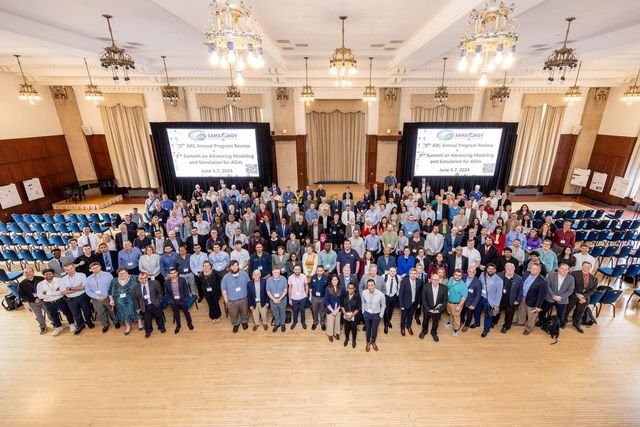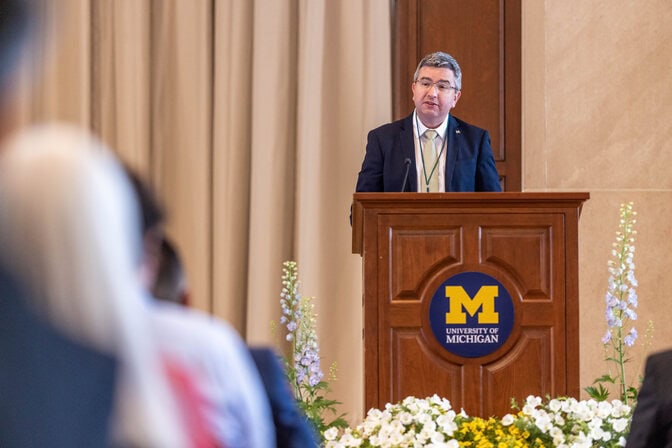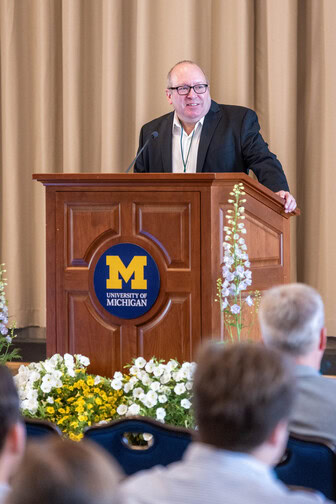
Automotive Research Center at U-M marks 30th anniversary, looks to the future
Digital engineering for autonomous vehicles will be the main focus of the center’s next five years.

Digital engineering for autonomous vehicles will be the main focus of the center’s next five years.
More than 400 researchers from industry, the military and academia converged on Ann Arbor recently to mark the 30th anniversary of the Automotive Research Center (ARC) led by the University of Michigan.
U-M hosted the event during the center’s June 5-7 Annual Program Review—an opportunity to celebrate three decades of research to continuously modernize the U.S. Army’s ground vehicle systems, as well as a chance to review current and future research poised to shape next generations of technology.

“Our projects, from creating synthetic environments with high-fidelity sensors to developing advanced vehicle dynamics and control systems, are setting new standards in the field,” said ARC Director Bogdan Epureanu, the Roger L. McCarthy Professor of Mechanical Engineering and a U-M professor of electrical engineering and computer science. “They shorten the cycle for adopting new technologies and enable sound investments by reducing risks and costs and by fostering innovations.”
In 1994, the Army chose Michigan Engineering to create and lead the ARC. What began with just five partner universities is now a 14-member collection of universities and institutes, featuring a total of 84 faculty members, 34 industry partners and four government agencies. In the earliest years of the ARC’s partnership, the bulk of its research focused on energy and powertrain issues.
That work led to advances such as accurate modeling of combat personnel and their gear to assist with vehicle design, engine design and performance simulations, blast modeling and simulation techniques, as well as a better understanding of lithium ion battery performance and design.

Innovations and approaches developed at the ARC often find their way into products and services that benefit the general public in ways beyond national security. An example is the company Ramdo Solutions that offers vehicle design tools based on technology developed at the ARC.
In recent years, ARC’s focus has shifted toward digital engineering and autonomous technologies that have become increasingly important to the military and beyond.

“The ARC has a strong history of transitioning capability to the community, not only from a technology perspective, but from a people perspective,” said David Gorsich, U.S. Army Ground Vehicle Systems Center chief scientist. “A shining example is Justin Storms, a former U-M student and the current director of engineering, autonomy and robotics at Refraction AI. This underscores ARC’s dual focus on technological advancements and developing skilled professionals, ensuring a comprehensive and lasting contribution to the field.”
In December, Army and U-M officials reached a new five-year cooperative agreement that could be worth as much as $100 million—potentially doubling the federal government’s investment in ARC since the previous agreement in 2019.
Joining Gorsich as keynote speakers at the 30th anniversary were: Col. Ryan A. Howell, program manager for main battle tank systems at the Program Executive Office Ground Combat Systems, Alvaro Velasquez, program manager for Transfer from Imprecise and Abstract Models to Autonomous Technologies at DARPA and Col. M. Ryan Howell, chief of staff for the Next Generation Combat Vehicle Cross-Functional Team, Army Futures Command.
“The ARC provides the critical bridge between academia, research and development, and the practitioners represented by the U.S. Army Soldiers involved in the efforts to transform future capabilities for national security,” said Col. M. Ryan Howell.
In the coming years, the ARC team will expand its applications toward digital engineering and will continue to bring together researchers working in engineering, machine learning, human factors and social behavior. And it fits within U-M’s broader mission of exploring the future of mobility—from autonomous and connected vehicle technology to battery research for electric vehicles.
Participating institutions include: the University of Iowa; Wayne State University; Clemson University; Oakland University; Virginia Tech; Michigan Technological University; Mississippi State University; the University of Alabama at Birmingham; the University of California, Irvine; George Mason University; Central Michigan University; Michigan State University and Worcester Polytechnic Institute.